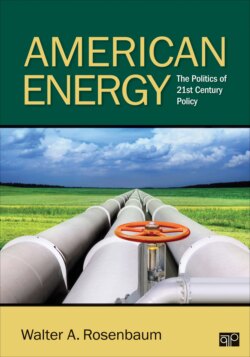Читать книгу American Energy - Walter A. Rosenbaum - Страница 26
На сайте Литреса книга снята с продажи.
Interest Groups
ОглавлениеSo embedded in government are organized interests that it often seems to critics of interest-group power, such as political scholar and commentator George Will, that if “you want to understand your government, don’t begin by reading the Constitution. Instead, read selected portions of the Washington telephone directory containing listings for all organizations with titles beginning with the word National.”49 Interest group access to the inner citadels of energy policymaking is treated with public ambivalence. It is the excesses, not the existence, of group claims to influence that invite censure. That privately organized interests should share in formulating public energy policy excites almost no one.
Energy-related interest groups have been among the largest contributors to congressional and presidential election campaigns, and, among the top spenders for lobbying among all national interest groups. In 2010, for instance, the nonpartisan Center for Responsive Politics, which monitors interest group political activities, reported that more than 1,600 individuals lobbied Congress and the White House on behalf of conventional and nuclear energy organizations.50 Since 1990, most of the money spent on political campaigns by the energy sectors has gone to Republican candidates.51 The energy sector is also among the largest of all interest groups contributing money to political campaigns and lobbying: in 2012–2013, this sector spent an estimated $144 million on such activity.52 Fossil fuel and nuclear power interests dominate the energy sector in campaign spending, lobbying, and other political activities.
The rise of new issues on the governmental agenda often triggers the formation of new groups and, conversely, new issues on the agenda reflect the growing political influence of new interests. In recent decades, traditional energy sector groups have been increasingly challenged politically by a relatively small but growing array of energy-related environmental groups, state and regional interests, and new technology advocates, especially groups promoting renewable and nonconventional energy.
Energy administrators routinely consult, formally and informally, with representatives of affected organized interests who become “stakeholders.” Congressional legislation frequently mandates that agencies responsible for implementing important legislation create advisory committees that include representatives of the programs affected by the legislation. If Congress fails to create an advisory committee, agencies often create their own. This ensures that these interests will be informed and solicited for their opinions during the program’s implementation. In the Department of Energy (DOE), for example, the National Petroleum Council, consisting of almost 100 individuals representing major energy producers, research institutions, technology producers and related groups, is among the high-level DOE advisory groups, reporting directly to the secretary of DOE. The agency assuredly does not lack advisory help. DOE has at least 20 high-level program advisory groups and has terminated another 60 since its creation. However, compared with older federal departments, many of which have more than 100 advisory groups, DOE is hardly in the business.53
Administrative agencies also collaborate with organized groups by “working the clientele.” Agencies turn to organized interests strongly supportive of their mission when help is needed. Thus, when DOE and the Environmental Protection Agency (EPA) struggle over congressional proposals to increase or relax pollution controls on public utilities, both sides mobilize their clientele to bring pressure on Congress. EPA appeals to environmentalists, DOE to utilities.
